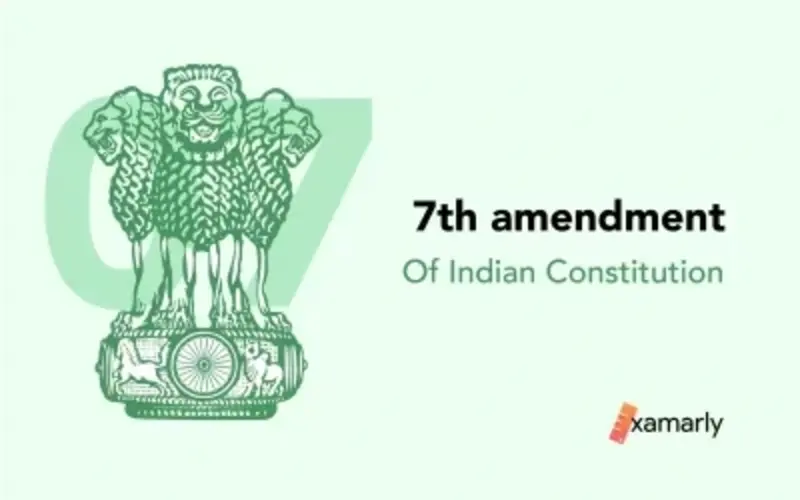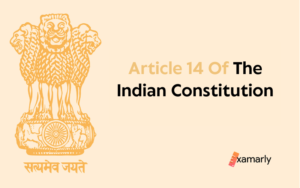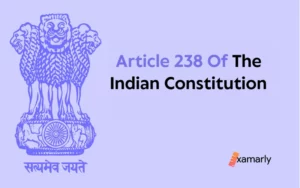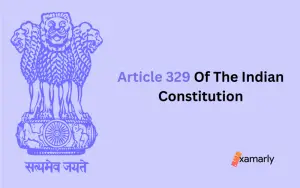The 7th amendment of the Indian Constitution was adopted in 1956. This led to the partition of the nation’s states. Additionally, modified the governors’ responsibilities and powers as well.
To put the recommendations of the States Reorganization Commission into practice, the Indian Constitution’s 7th Amendment was required. This amendment aimed to reorganize the states according to linguistic distinctions.
The State Reorganization Act of 1956 was put into effect owing to the 7th amendment of the Indian Constitution. This was suggested by State Reorganization Committee.
This blog is about the 7th Amendment of the Indian Constitution which will assist you in your UPSC examination.
- 7th Amendment of the Indian Constitution
- State Reorganisation Act, 1956
- Article 153 Amended by 7th Amendment
- Article 171 Amended by 7th Amendment
- Article 258A Amended by 7th Amendment
- Amendments
- Added Articles to the 7th CAA
- Substitute Articles in the 7th CAA
- Implications
- Conclusion
- UPSC Previous Year Question on 7th CAA
- Frequently Asked Questions
- What is the 7th Amendment of the Indian Constitution?
- What alterations were implemented through the 7th Amendment to the Indian Constitution?
- When was the 7th Amendment of the Indian Constitution passed?
- What is the significance of the 7th Amendment to the Indian Constitution?
- Why was the 7th Amendment of the Indian Constitution necessary?
- How did the 7th Amendment of the Indian Constitution impact state segregation?
- Which states were affected by the unique rules set down by the 7th Amendment of the Indian Constitution?
- What were the term durations established by the 7th Amendment of the Indian Constitution?
- What was the purpose of introducing term limits in the 7th Amendment of the Indian Constitution?
- How did the 7th Amendment of the Indian Constitution impact the appointment of governors?
7th Amendment of the Indian Constitution
To replace the old framework, the 7th amendment was adopted into the constitution. This confirms state segregation as well.
The 7th Constitutional Amendment of India made term durations available for various positions. Additionally, this facilitated the appointment of governors in two or more states. Additionally, it set down unique rules for the states of Punjab and Andhra Pradesh.
Amendment legislation governed the establishment of 14 states and 6 territories. This caused a lot of issues for the local populace, which resulted in the law’s repeal. Amendments:
- The two schedules of the Indian Constitution were changed, namely the Second and Seventh.
- Eliminated the current division of states into parts A, B, C, and D states. Additionally, rearranged into Fourteen states and Six union territories.
- Added union territories to the high courts’ area of jurisdiction.
- Created a framework for the creation of a unified high court for 2 or more states.
- Allowed for the high court’s acting and extra judges to be appointed.
- The fourth schedule had a significant revision. As a result, the allocation of seats in the Council of States was managed.
- A more comprehensive entry that covers the entire topic has been added in place of entries 42 of the Concurrent List, 33 of the Union List, and 36 of the State List.
State Reorganisation Act, 1956
The State Reorganisation Act was enacted in 1956 by the Indian Parliament. This led to the creation of a federal government in 14 states and 5 territories.
- When the widespread rioting broke out, about 80 people died. Immediately after that, Maharashtra’s amendment was announced.
- As a result, Gujarat and Maharashtra were created out of the state of Bombay. Bombay was created as an independent state. But due to constant opposition and public outcry, it was later converted to be a part of Maharashtra.
- Bombay and Ahmedabad were proclaimed as the capitals of Gujarat and Maharashtra.
- All the states and the union territories were involved in a complete revision of the 4th list of the constitution as part of Section II of the State Reorganisation Act of 1956. The seats in the Council of States were awarded to the present states.
Main Points:
- The classification among Part A, B, C, and D States was erased.
- It outlined two divisions of organizational units: States and Union domains.
- The Rajpramukhs’ positions were abolished.
- Six associate regions and 14 new states were created.
Article 153 Amended by 7th Amendment
This was established as a governor-appointed state governor. This led to conflicts of understanding between the governors and states that could not operate. Thus, more than one governor could be appointed at once.
Main Points:
- Each State will have a governor.
- Choosing a Governor for at least 2 States may be appealing under certain circumstances.
- It is suggested that an agreement be added to article 153 to remove any potential specialized barriers to such a deal.
Article 171 Amended by 7th Amendment
A state’s legislative council was said to have the greatest composition of around 25% of the state’s whole Legislative Assembly. This rule is valid in large states such as Bihar and Uttar Pradesh but it does not apply to smaller states, which can lead to functional problems.
The State’s Legislative Assembly was weakened, with its size reduced to just one-third of its original strength.
Main Points:
- The maximum composition of a State’s Legislative Council is set at 1/4th of the strength of that State’s Legislative Assembly.
- While this is satisfactory in larger states such as Uttar Pradesh. It causes problems in smaller states.
- The greatest is recommended to be changed to 33% of the whole membership of the Legislative Assembly.
Article 258A Amended by 7th Amendment
According to the amendment of Article 258A of the 7th Constitutional Amendment Act, the Indian President granted state governors authority over Union territories.
But, this clause prohibits the governor from handing over control or responsibility for the Union territory to the central government.
Later, this was revised to address this leadership transition issue. The governor of each state was given the power to assign any tasks to the officers stationed there.
The governor of India approved this transfer of responsibilities as long as state rules were fulfilled. He had also given his approval to this transfer of responsibilities if the local rules were respected.
Amendments
- Article 1– The split of states based on Parts was eliminated as part of the revisions made. States were used in place of Parts A and B. States in Parts C and D were replaced by Union territories. There were added 14 states along with 5 union territories.
- Article 168(1)(a) – For some states, the clause establishes bicameral legislatures. A bi-cameral legislature was added for the newly formed Madhya Pradesh. The word “Madras” was followed by the word “Mysore.”
- Article 153– The selection of a governor for each state turned into a problem with inefficiency. It was discovered that a governor could oversee two or more states, doing away with the need to appoint governors for each state and territory. The President was unable to proceed because of the article’s provision, thus, a constitutional revision was required. By the seventh amendment, this was changed to permit the allocation of more than one state to a governor as needed.
- This pertains to the upper limit of the State’s Legislative Council’s membership, as outlined in Article 171. According to the suggestion, the largest number of members was changed to one-third or 33% of the total number of members of the legislative assembly.
- Article 216– This sets the number of judges for each High Court. This enables the President to propose as many judges as required for a High Court. Since the largest number can be altered at any time, it was deemed unnecessary and left out.
- Article 217(1)– It was amended to add the words “in the case of an additional or acting Judge, as provided in Article 224, and in any other case” to the existing words of the provision “shall hold office until he attains the age of sixty years”
- Article 222– This has been changed to exclude clause (2). Additionally, it removes the phrase “within the territory of India” from clause (1). It relates to the President’s authority to move judges among the High Courts. Since providing a transfer allowance wasn’t essential, clause (2) was removed.
- Articles 230 and 231– The creation of state high courts is the subject of these. While Article 231 calls for the establishment of a high court with jurisdiction over two or more states, this allows for the Parliament to expand the High Court’s jurisdiction.
The following enables the students to supplement their preparation for the UPSC Exam on Indian Politics.
Added Articles to the 7th CAA
The following new articles have been added to the 7th Amendment of the Indian Constitution:
- This deals with the authority of the President to delegate Union duties to a State Government or its representatives, as specified in Article 258A. The addition of this gave state governors the authority to delegate Union duties to the central government or its representatives.
- Article 290A– To guarantee yearly payment to specific Devaswom Funds, this was included. These funds came from the State of Kerala and the State of Madras’ Consolidated Fund. This was done to keep the Hindu temples and shrines in the areas that were ceded to that State in good condition.
- By new article 350A, every State must offer linguistic minority children facilities for instruction in the mother tongue at primary-level learning.
- A new article 350B that has been added allows the President to designate Special Officers, whose responsibility it is to look into any issues relating to the protections the Constitution offers for language minorities.
Substitute Articles in the 7th CAA
- Article 131– Due to the absence of Part B states the clause in this article was amended. It discusses the Supreme Court’s original jurisdiction. The jurisdiction of the Supreme Court needs to be revised because the Part B states have changed.
- Article 220– Before, a clause in Article 220 of the Constitution forbade retired judges from continuing their legal careers. As a result of the reform, retired High Court judges are now eligible to serve on the Supreme Court and in High Courts, but not the ones where they served as permanent judges.
- Articles 230 and 231– These articles discuss the creation of state high courts. After the changes, a High Court’s jurisdiction could be expanded to a Union territory if needed.
- Article 224– The replacement article concerns the appointment of extra and acting judges. This is required when a High Court’s Chief Justice is absent or unavailable.
- Articles 239 and 240– The president’s authority to enact laws governing the Union territory of the Andaman and Nicobar Islands as well as the Minicoy, Laccadive, and Amindivi Islands is covered by these articles. A president-selected administrator will also be in charge of the administration of Union territory.
- Article 298– This substitute strengthened the ability of the Union and State governments to undertake trade and business.
- Article 371- Article 371 was replaced with a new one that applies to the states of Andhra Pradesh, Punjab, and Bombay. This introduced a special provision that enables the President to direct the creation of regional committees within a state’s Legislative Assembly.
- Articles 81 and 82– It was suggested to merge and change Clause 2 of 81 and 82. This was done to include requirements for Union Territories.
Implications
The portions of the Constitution that deal with the High Courts and their judges, a few legislative lists, and the executive power of the States and the Union all needed to be amended to carry out the plan of States Reorganization.
Conclusion
The 7th amendment of the Indian constitution introduced many changes to the Indian Constitution. It also aided in the development of high courts in every state. Also allowed for their decisions to be of the highest order along with the establishment of State laws in India.
Additionally, it resulted in the hiring of administrators to oversee the Union Territories. Subsequently, these officials were designated as Lieutenant Governors of Union Territories.
UPSC Previous Year Question on 7th CAA
Q1. Which article of the constitution provides that every state shall endeavour to provide adequate facility for instruction in the mother tongue at the primary stage of education? (UPSC 2001)
(a) Article 349 (b) Article 350
(c) Article 350(A) (d) Article 351
Ans. (c) Article 350(A) was the right answer. 7th CAA added this article to the Indian Constitution.
Frequently Asked Questions
What is the 7th Amendment of the Indian Constitution?
The 7th Amendment of the Indian Constitution was enacted in 1956 to make significant changes to the Constitution, including the provision of term limits for various positions and the appointment of governors in multiple states.
What alterations were implemented through the 7th Amendment to the Indian Constitution?
The 7th Amendment of the Indian Constitution introduced various changes, such as the establishment of term limits for various positions, the appointment of governors in multiple states, and the introduction of specific regulations for the states of Punjab and Andhra Pradesh.
When was the 7th Amendment of the Indian Constitution passed?
The 7th Amendment of the Indian Constitution was passed in 1956.
What is the significance of the 7th Amendment to the Indian Constitution?
The 7th Amendment of the Indian Constitution is significant because it introduced several crucial changes to the Constitution, which are still in effect today.
Why was the 7th Amendment of the Indian Constitution necessary?
The 7th Amendment of the Indian Constitution was necessary to bring about various reforms, such as the establishment of term limits for various positions and the appointment of governors in multiple states, which were not provided for in the original Constitution.
How did the 7th Amendment of the Indian Constitution impact state segregation?
The 7th Amendment of the Indian Constitution confirmed the continued existence of state segregation, which was already present in the original Constitution.
Which states were affected by the unique rules set down by the 7th Amendment of the Indian Constitution?
The 7th Amendment of the Indian Constitution introduced specific regulations for the states of Punjab and Andhra Pradesh.
What were the term durations established by the 7th Amendment of the Indian Constitution?
The 7th Amendment of the Indian Constitution introduced term limits for various positions, although the specific durations varied depending on the position.
What was the purpose of introducing term limits in the 7th Amendment of the Indian Constitution?
The purpose of introducing term limits in the 7th Amendment of the Indian Constitution was to ensure that individuals did not hold positions of power for an indefinite period, thereby promoting democracy and preventing the concentration of power.
How did the 7th Amendment of the Indian Constitution impact the appointment of governors?
The 7th Amendment of the Indian Constitution facilitated the appointment of governors in two or more states, which was not previously possible under the original Constitution.






